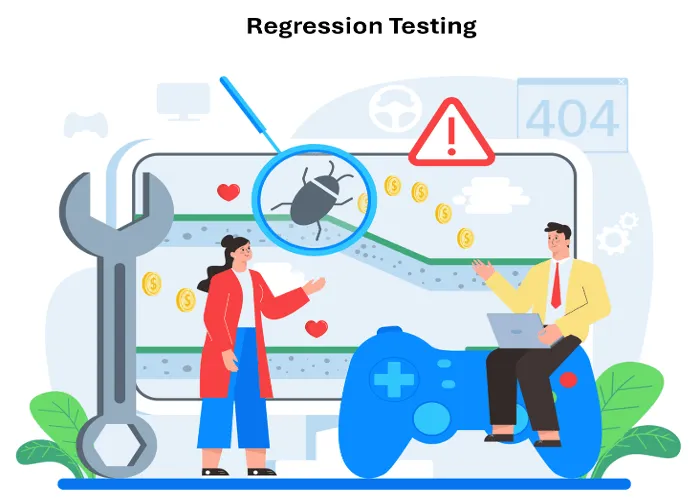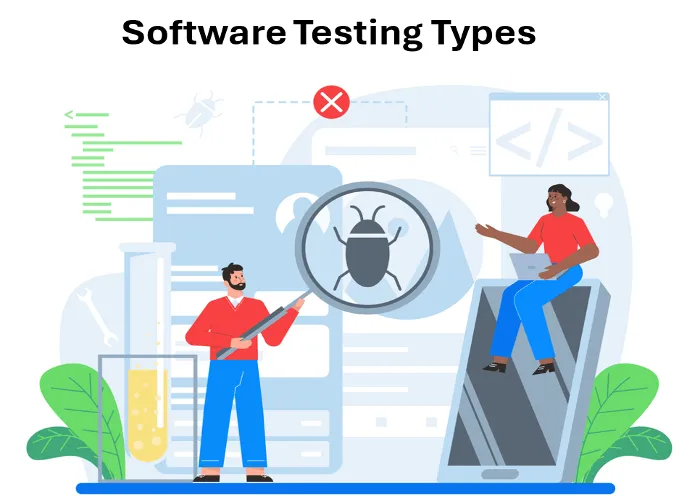Regression Testing Know the Fundamentals in the STLC

Introduction
Ensuring the stability and reliability of applications is of utmost importance. Among the many pillars upholding software quality, regression testing stands tall as a crucial safeguard against unintended consequences of code changes. In this comprehensive guide, we will explore the intricacies of regression testing, from its fundamentals to best practices, common challenges, and a blueprint for a successful regression testing strategy.
Understanding Regression Testing
Regression testing is a critical component of the software testing process, ensuring the stability and reliability of software applications following changes or updates to the codebase. This involves retesting existing functionalities to verify that recent modifications, enhancements, or bug fixes have not introduced unintended side effects or regressions. The primary goal is to validate that the software behaves as expected and that no new defects have been introduced during development.
During regression testing, testers systematically rerun test cases, either manually or automated, to detect regressions - unintended side effects or failures introduced by alterations to the codebase. Testers validate that the software behaves as expected during regression testing, analyzing test results to identify any deviations from expected behavior. Any defects or regressions detected are reported and tracked for resolution.
The significance of regression testing amplifies as software complexity grows, making it indispensable in the software testing life cycle. The main purpose is to detect and prevent defect regressions, ensuring that existing functionalities remain intact and unaffected by changes.
Regression testing is essential for reducing risks linked to software modifications, ensuring the software’s overall quality and reliability, and fostering customer satisfaction and confidence in the product.
When to Perform Regression Testing
Regression testing should be performed in various scenarios to ensure the stability and reliability of software applications. Here are the cases when regression testing should be conducted:
After Code Changes:
Regression testing is essential after any modifications, enhancements, or bug fixes to the software codebase. It ensures that new modifications won’t cause regressions or unexpected issues impacting current functionalities.
Before Major Releases:
Prior to a significant software release or deployment, regression testing should be conducted to validate the integrity of the application. This helps mitigate the risk of introducing regressions into the production environment and ensures a smooth release process.
After Integrating Code Branches:
When merging code branches or integrating changes from multiple developers, regression testing is necessary to detect any conflicts or inconsistencies. It helps identify regressions caused by code merges and ensures the stability of the integrated codebase.
Following System Upgrades or Patch Installations:
After upgrading system components, libraries, or third-party dependencies, regression testing is crucial to verify that the upgraded components do not adversely affect the application’s functionality. Similarly, after installing patches or updates to the operating system or software dependencies, regression testing should be performed to ensure compatibility and stability.
Change in Configuration Settings:
Regression testing is necessary when there are changes in configuration settings, such as database configurations, server settings, or environment variables. Changes in configuration can impact the behavior of the application, and regression testing helps ensure that the software functions correctly under new configurations.
Periodically During Development Lifecycle:
Regression testing should be performed periodically throughout the software development lifecycle to maintain software quality and reliability. Regular regression testing aids in early detection and resolution of regressions, thereby preventing their accumulation and mitigating the challenge of fixing them later in the development process.
After Performance Optimization:
When optimizing the performance of the application, regression testing should be conducted to ensure that performance enhancements do not introduce regressions or degrade existing functionalities. Performance optimizations, such as code refactoring or database tuning, can inadvertently impact the behavior of the application, making regression testing essential.
After Security Patches or Vulnerability Fixes:
Following the installation of security patches or fixes for identified vulnerabilities, regression testing is necessary to ensure that the patched vulnerabilities do not introduce regressions or compromise the application’s security posture.
Security patches or fixes may alter the behavior of the application, and regression testing helps validate that the fixes are effective without introducing new vulnerabilities. By performing regression testing in these cases, organizations can proactively identify and address regressions, ensuring the stability, reliability, and security of their software applications.
Manual vs. Automated Regression Testing
Before deciding whether to perform regression testing manually or through automation, several key factors should be considered to make an informed choice:
Test Case Complexity:
Manual Testing: Suitable for complex test scenarios that require human judgment, exploratory testing, and ad-hoc testing. Automation: Preferable for repetitive, predictable test cases with clear expected outcomes and limited variability.
Time Constraints:
Manual Testing: Time-consuming for large-scale regression testing efforts due to manual execution and verification of test cases. Automation: Faster execution of test cases, allowing for rapid feedback and quicker regression testing cycles, especially in agile and continuous integration environments.
Resource Availability:
Manual Testing: Requires a significant investment in human resources, including skilled testers capable of performing thorough and accurate regression testing. Automation: Initial investment in automation tools, frameworks, and infrastructure, followed by reduced dependency on manual effort once automated tests are in place.
Cost Considerations:
Manual Testing: Higher operational costs associated with employing manual testers, especially for long-term or recurring regression testing efforts. Automation: Upfront investment in automation tools and infrastructure, followed by potential long-term cost savings due to reduced manual effort and increased efficiency in regression testing.
Test Coverage:
Manual Testing: Subject to human limitations, may result in incomplete test coverage, especially for large and complex applications. Automation: Enables comprehensive test coverage by executing a large number of test cases consistently and repeatedly, including edge cases and integration scenarios.
Repeatability and Consistency:
Manual Testing:
Prone to human error and variability in test execution and results interpretation, leading to inconsistent regression testing outcomes.
Automation:
Provides repeatability and consistency in test execution, ensuring uniformity in regression testing results across multiple runs and environments.
Maintenance Effort:
Manual Testing:
Test cases need to be executed manually for each regression testing cycle, requiring ongoing effort and resources for test case maintenance.
Automation:
Initial investment in test script development and maintenance, followed by reduced effort for regression testing as automated tests can be reused and updated easily.
Test Environment Stability:
Manual Testing:
Less dependent on test environment stability as human testers can adapt to variations and troubleshoot issues during regression testing.
Automation:
Requires stable and consistent test environments to ensure reliable and reproducible test results, with potential disruptions in automated test execution due to environment changes.
Skill Level of Testers:
Manual Testing:
Relies on the expertise and experience of manual testers to identify defects, perform exploratory testing, and validate complex scenarios.
Automation:
Requires skilled automation engineers proficient in scripting languages, test automation frameworks, and software development best practices to design, develop, and maintain automated test suites.
By carefully evaluating these factors, organizations can make an informed decision about whether to perform regression testing manually or through automation, selecting the approach that best aligns with their project requirements, resource constraints, and long-term testing objectives.
Successful Regression Testing Strategy
A successful regression testing strategy encompasses several key components to ensure comprehensive coverage, efficiency, and effectiveness in detecting regressions. Here’s a breakdown of these components:
Regression Test Suite Composition:
Identifying Critical Functionality:
Determine the core features and functionalities of the software that are vital for its operation.
Choosing Test Cases:
Assemble a collection of test cases that address essential workflows, boundary scenarios, and integration aspects. Prioritization: Prioritize test cases based on factors such as business impact, frequency of use, and risk assessment.
Automation Framework Selection:
Assessment of Requirements:
Evaluate project requirements, technology stack, and scalability needs to choose a suitable automation framework. Tool Selection: Select appropriate automation tools and technologies that align with project goals and testing objectives.
Customization:
Customize the automation framework to accommodate specific testing scenarios and integrate seamlessly with existing workflows.
Continuous Integration and Regression Test Selection:
Integration with CI/CD Pipeline: Integrate regression testing seamlessly into the continuous integration and continuous deployment (CI/CD) pipeline.
Trigger Mechanism:
Implement triggers to automatically initiate regression tests upon code changes, merges, or deployments. Regression Test Selection Criteria: Employ techniques like impact analysis, code coverage metrics, and risk assessment to select relevant test cases for regression testing.
Test Data Management:
Data Preparation:
Prepare relevant and representative test data that mimic real-world scenarios and cover various use cases.
Data Anonymization and Masking:
Implement techniques to anonymize and mask sensitive data to ensure compliance with privacy regulations.
Data Refreshment:
Regularly refresh test data to maintain its relevance and validity throughout the regression testing process.
Execution and Reporting:
Execution Strategy:
Define a systematic approach for executing regression tests, considering factors such as test environment stability, parallel execution capabilities, and resource utilization.
Monitoring and Analysis:
Monitor test execution progress, analyze test results, and identify regressions promptly.
Comprehensive Reporting:
Generate detailed reports summarizing test execution results, regression findings, and actionable insights for stakeholders.
Performance Optimization:
Efficiency Improvements:
Continuously optimize regression testing processes to enhance efficiency, reduce test execution time, and minimize resource consumption.
Parallel Execution:
Implement parallel execution of test cases to expedite regression testing and maximize utilization of available resources.
Test Environment Management:
Maintain stable and consistent test environments to ensure reliable and reproducible test results.
Feedback Loop and Continuous Improvement:
Feedback Mechanism:
Establish a feedback loop to gather input from stakeholders, developers, and testers to improve regression testing practices.
Root Cause Analysis:
Conduct thorough root cause analysis of identified regressions to understand underlying issues and prevent recurrence.
Iterative Enhancement:
Continuously refine and enhance the regression testing strategy based on lessons learned, emerging trends, and evolving project requirements.
By incorporating these key components into a regression testing strategy, organizations can establish a robust framework for ensuring software quality, reliability, and resilience against regressions throughout the software development life cycle.
Challenges and Mitigation Strategies:
Though essential for preserving software quality, regression testing often involves multiple challenges. Here are key challenges and strategies to mitigate each:
Test Case Maintenance:
Challenge:
Over time, test cases may become outdated or irrelevant due to changes in the application’s functionality or requirements.
Mitigation:
Regularly review and update test cases to align with evolving requirements and changes in the application. Enable version control for test cases to monitor changes and maintain traceability.
Resource Constraints:
Challenge:
Limited time, budget, and skilled resources may hinder comprehensive regression testing efforts.
Mitigation:
Prioritize critical test cases based on business impact and risk assessment. Leverage automation to reduce manual effort and increase test coverage. Allocate resources efficiently by focusing on high-risk areas of the application.
Test Environment Stability:
Challenge:
Inconsistent or unstable test environments can lead to unreliable test results and false positives/negatives.
Resolution:
Ensure test environments are stabilized to closely replicate production conditions. Implement environment configuration management to maintain consistency across different environments. Consistently verify and update test environments to maintain their dependability.
Scope Creep:
Challenge:
The scope of regression testing may expand uncontrollably, leading to inefficiencies and delays in testing cycles.
Mitigation:
Define clear regression testing scope and criteria upfront. Prioritize all test cases based on business impact and risk assessment. Establish change control processes to prevent scope creep and manage changes effectively.
Test Data Management:
Challenge:
Managing relevant and representative test data can be challenging, especially when dealing with sensitive or confidential information.
Mitigation:
Implement data anonymization and masking techniques to protect sensitive data during regression testing. Maintain a comprehensive test data management strategy to ensure data integrity, confidentiality, and relevance. Regularly refresh test data to maintain its validity and relevance.
Automation Challenges:
Challenge:
Automation may face challenges such as script maintenance, tool compatibility, and scalability.
Mitigation:
Choose robust automation tools and frameworks that align with project requirements and technology stack. Invest in automation script design and architecture to enhance maintainability and scalability. Regularly review and update automation scripts to adapt to changes in the application.
Dependency Management:
Challenge:
Dependencies on external systems, libraries, or services may impact the reliability and repeatability of regression testing.
Mitigation:
Identify and manage dependencies proactively. Use stubs, mocks, or virtualization techniques to simulate external dependencies and isolate them during regression testing. Regularly validate dependencies to ensure compatibility and reliability.
Communication and Collaboration:
Challenge:
Inadequate communication and collaboration between stakeholders, development, and testing teams may lead to misunderstandings and delays in regression testing.
Mitigation:
Foster open communication channels and collaboration between stakeholders, development, and testing teams. Establish clear roles, responsibilities, and expectations for every stakeholder involved. Hold regular meetings and checkpoints to facilitate communication and coordination.
By addressing these challenges proactively and implementing effective mitigation strategies, organizations can overcome obstacles in regression
Conclusion:
Regression testing serves as a linchpin in the software testing life cycle, safeguarding software quality and integrity against the tide of changes. By embracing the principles outlined in this guide, organizations can fortify their regression testing practices, mitigate risks, and deliver robust, reliable software solutions that meet the evolving needs and expectations of users. Whether through manual effort or automation, regression testing remains an indispensable tool in the arsenal of software testing professionals, ensuring that software applications withstand the test of time and deliver value to end-users consistently.




🗨️ Reader Comments